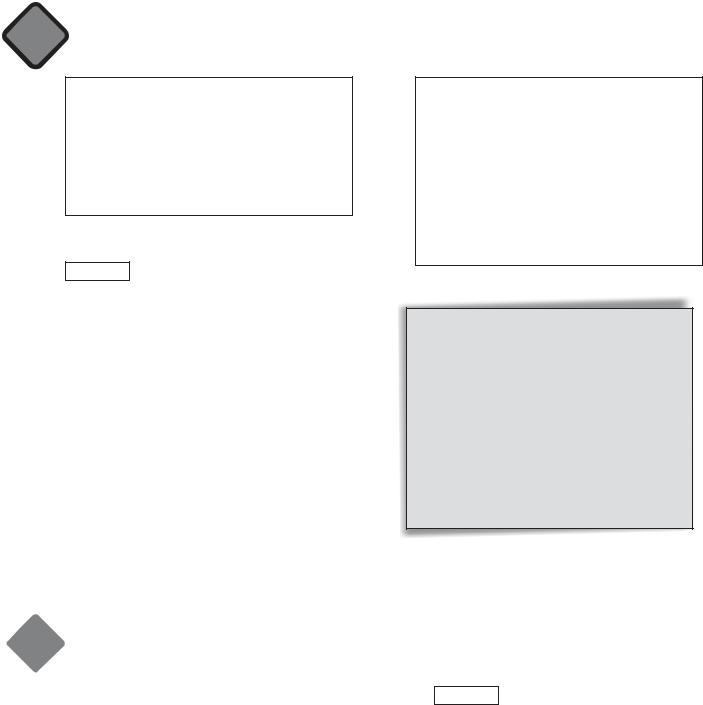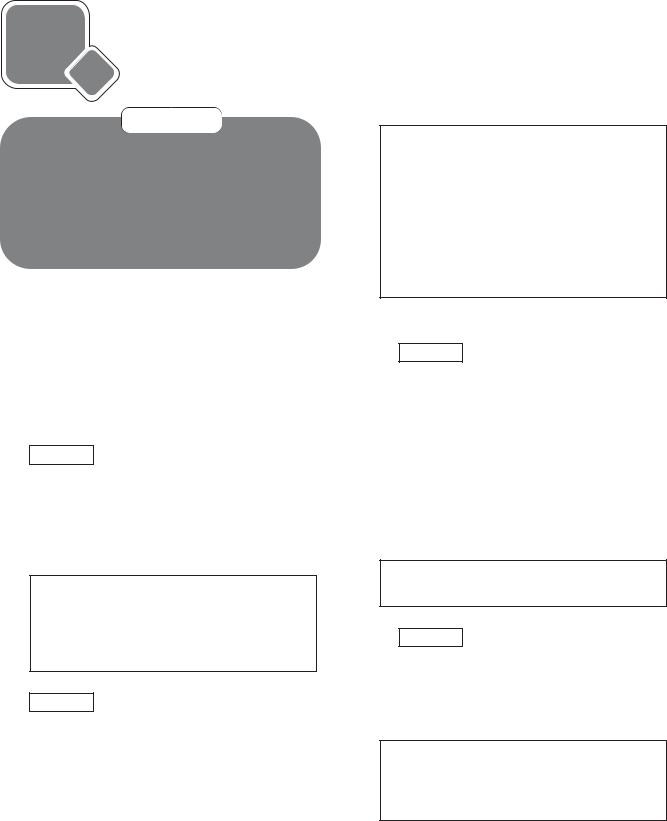
Sportlight_7
.pdf
2 c Vanished!
Objectives
Reading & Listening: a mystery story
Writing: a story
Introduction
Draw Ss’ attention to the title, Vanished, and ask them what they think it means (sth that has disappeared). Ask them if they’ve ever had a mysterious experience. Encourage Ss to predict what vocabulary they will see in the unit.
Reading & Listening
1 a) Focus Matching words to sounds
Tell Ss they are going to listen to sounds and to say which ones are made by people. Go through the words a-g with Ss and explain any unknown words. Play recording (twice if necessary). Ss number the boxes and compare their answers with their partner. Check answers. Ask Ss what sounds are made by people. Check answers around the class.
|
Answer Key |
|
|
|
|
|
|
|
||
|
a |
8 |
b |
6 |
c |
9 |
d |
5 |
e |
10 |
|
f |
7 |
g |
4 |
h |
3 |
i |
1 |
j |
2 |
|
All of these sounds are made by people except |
|||||||||
|
storm and gust of wind. |
|
|
|
|
|||||
|
|
|
|
|
||||||
b) |
Read the rubric and explain the task. |
|
|
|||||||
|
|
|
|
|
|
|
|
|
||
|
Answer Key |
|
|
|
|
|
|
|
||
|
a sigh ― to sigh |
|
a chat ― to chat |
|
|
|||||
|
a snore ― to snore |
|
a storm ― to storm |
|||||||
|
a cry ― to cry |
|
a whisper ― to whisper |
|||||||
|
a gasp ― to gasp |
|
a yawn ― to yawn |
|
||||||
|
a laugh ― to laugh |
|
|
|
|
|
|
|||
|
|
|
|
|
|
|
|
|
|
|
c) Focus Predicting content
Ask Ss to look at the pictures. Allow Ss time to tell the story, in pairs. Play the recording. Ss listen and read. Ask a few Ss to try and tell the story. Ask Ss the last question in the rubric.
Elicit answers around the class. Check Ss’ understanding.
Suggested Answer Key
ñLast winter some friends went to stay in their uncle’s house. The lights went out and they couldn’t find Andy. When the lights came on they found him behind a sofa.
ñIt is a real life story.
2 a) Focus Reading for specific information
Ask Ss to read the questions so they know what information they are looking for. Ask Ss to read the story again and answer the questions. Allow Ss time to complete the task. Ss compare answers. Check answers.
Answer Key
1 At John’s uncle’s house in the country.
2 It was stormy.
3 Andy was missing.
4 The children were confused and scared.
5They found Andy asleep behind a sofa.
b)Focus Building vocabulary
Ask Ss to explain the meaning of the words in bold without the use of a dictionary, i.e. they can use synonyms, paraphrase etc. Elicit/Explain the meanings and write them on the board. Ss should copy the words into the vocabulary section of their notebooks.
Answer Key
cosy (adj): warm and comfortable powerful (adj): very strong
went out (phr v): switched off
power cut (exp): stoppage of electricity supply confused (adj): didn’t know what was happening fast asleep (exp): in a deep sleep
velvet (n): soft material made from cotton, silk or nylon
31

2c Vanished!
rubbing (v): moving your hands back and forward over sth
snooze (v): a short light sleep
relieved (adj): felt glad that sth was over
Game
Focus Chain story
Ss play in teams. One S starts by continuing the story from the sentence given. Then a S from the other team continues the story.
Suggested Answer Key
AS1: … and turned the corner.
BS1: As he turned the corner he saw some strange lights in the sky.
AS2: Then a spaceship landed in front of him … etc
Writing
3Focus Writing a story
ñDraw Ss’ attention to the Study Skills box. Read through the study skills for sequencing events. Explain to Ss that before writing it is important to have a plot i.e. to decide on the characters and the events. Explain that this helps the reader follow your story more easily.
ñGo through the rubric with Ss and elicit key words (school magazine, adventure/humorous/ mystery story, characters, place, time, events in order, climax event, feelings). Refer Ss back to the story in Ex. 1 and tell them they can use it as a model. Brainstorm ideas and write them on the board. Allow Ss time to complete the task in class. Go around the classroom monitoring Ss’ work and helping with any difficulties. Ss compare work. Check Ss’ work and give feedback. Alternatively, you can assign the task for HW provided you have gone through it orally in class.
Suggested Answer Key
It was a bright, spring morning and Elizabeth and her two best friends, Catherine and Becky, decided to go away for the weekend. After a while they got hungry, so they stopped to get something to eat. Becky and Elizabeth went into the shop while Catherine stayed in the car.
When the two girls walked back to meet Catherine, they realized the car was not there anymore. They glanced around and noticed it was parked behind the shop. After a few minutes they both began to worry, as they couldn’t see Catherine.
Then they heard a voice coming from a shed behind the shop. It was Catherine. She (had) wanted to go to the WC and the door (had) locked behind her. She was inside for nearly an hour. After a few minutes of laughter and tears, the girls were back on the road and all was well.
32

2 d Culture Corner
Additional materials
Book of popular folktales
Reading & Listening
1Focus Stimulating interest in text
Tell Ss they are going to listen to music and to say what country it reminds them of. Play recording. Elicit replies from Ss. Stimulate discussion based on their replies. Ask how they think the song is related to the title of the text.
Answer Key
It’s Ireland ― because Ireland has a tradition of storytelling.
2 a) Focus Predicting text content
Ask Ss to look at the picture and to read the quote and to say what they think the text might be about. Elicit ideas from around the class and simulate discussion by asking Ss to justify their answers.
Suggested Answer Key
The text might be about storytelling because the quote talks about a story and we see a picture of an old man reading a book to two children.
It might be about fairies because there is a picture of a fairy. etc.
b) Focus Reading for specific information
Ask Ss to read through the questions so they know what information they are looking for. Ask Ss to read the text again and to answer the questions. Allow Ss some time to complete the task. Go around the classroom monitoring Ss’ work and helping with any difficulties. Ss compare answers with their partner. Check answers.
Answer Key
1 Seanachais tell stories.
2 Myths and legends, and folktales.
3They are about giants, saints, warriors and kings.
4 Fairies, elves, leprechauns and more.
3 a) Focus Building vocabulary
Ask Ss to look back over the text to find the adjectives used for the words. Allow Ss time to complete task. Ss compare answers. Check answers.
Answer Key |
|
beasts: magical |
adventures: incredible |
champion: noble |
obstacles: great |
values: moral |
location: secret |
characters: unusual, |
|
popular |
|
|
|
b) Focus Building vocabulary
Ask Ss to explain the meaning of the words in bold without the use of a dictionary, i.e. they can use synonyms, paraphrase etc. Elicit/ Explain the meanings and write them on the board. Ss should copy the words into the vocabulary section of their notebooks.
Answer Key
tradition (n): a practice that has existed for a very long time
saints (n): people who have been honoured by the Christian church for being an example to others
warriors (n): very good soldiers/fighters overcome (v): survive something difficult champion (n): a person who wins competitions
4Focus Remembering facts
Ss work in pairs. Ask Ss to close their books and discuss what the text says about the characters. Allow Ss time to discuss in pairs and ask them to tell the class what they discussed. Check Ss’ answers around the class, correcting where necessary.
33

2d Culture Corner
Suggested Answer Key
Finn Mac Cumhal was a noble champion and warrior.
The Fianna was a group of warriors to which Finn Mac Cumhal belonged.
Leprechauns are a type of fairy that make shoes and have a crock of gold.
Writing
5Focus Writing a folk tale
ñGo through words ( about,
Brainstorm You can tales to
ñSs work complete classroom any other give version feedback for HW in class.
Suggested Answer Key
Tir na nog
There is an Irish tale that says there is a place called Tir na nog, or country of the young, where people live fovever. But only one man, Oisin, has gone there and came back. He lived there for 300 years and came back on a white horse to look for his friends. When he got off his horse and touched the ground he became very old and died.
Synergy
ñAllow Ss one minute to think of ten words they have learnt in today’s lesson. Ask Ss to use them to make their own sentences.
ñWhen Ss have finished ask them to get up and go around the class to find a partner who has something in common with them e.g. same hair/eye colour, same clothes, same taste in music, etc.
ñAsk Ss to discuss what they have learnt in the lesson with their partner.
2 |
|
English in Use |
|
|
|
|
|
Reading & Listening |
|||
|
|
Listening and repeating |
|
1 a) |
Focus |
||
Ask Ss to read the phrases quietly to themselves. Elicit/Explain any unknown words. Tell Ss they are going to listen to the phrases and repeat them one by one. Play recording, pausing after each phrase for Ss to repeat. Correct Ss’ pronunciation and intonation.
b) Focus Predicting content
Explain to Ss that the sentences they just heard are from a dialogue between two friends. Draw Ss’ attention to the written dialogue and the picture and ask them to read the first two exchanges. Have two Ss repeat as a role play. Ask Ss what they think happened to Penny. Elicit ideas from around the class. Play recording. Ss check to see if they guessed correctly. Check answers with class.

Suggested Answer Key
Penny went to the zoo and suddenly she heard people screaming. Then she saw a snake swimming around in a fountain. The guards caught it and put it back in its cage.
2Focus Listing events in order
Read the rubric and explain the task. Allow Ss time to complete the task individually. Go around the classroom monitoring Ss’ work and helping where necessary. Ss compare answers. Check answers and write them on the board in the correct order.
Answer Key
1 Penny was at the zoo.
2 She heard people shouting and screaming.
3 She saw a snake swimming in the fountain.
4 The guards caught it.
5 The guards put it back in its cage.
Speaking
3Focus Role playing a dialogue
ñRead the rubric and explain the task. Tell Ss to use the phrases from Ex. 1a and the dialogue in Ex. 3 to help them. Go through a skeleton dialogue with Ss on the board. In pairs, Ss perform task. Go around the classroom monitoring Ss’ work and helping with any difficulties.
Student A |
|
|
|
Student B |
||||
Tell SB something |
|
|
|
|
|
|
|
Sound interested |
|
|
|
|
|
||||
strange happened. |
|
|
|
and ask what. |
||||
Tell SB in the order |
|
|
|
|
|
|
Express surprise/ |
|
|
|
|
|
|
||||
the events happened. |
|
|
|
disbelief. |
||||
Tell SB how it ended |
|
|
|
|
|
Say what you think |
||
|
|
|
||||||
and how you felt. |
|
|
|
of what happened. |
||||
|
|
|
|
|
|
|
|
|
English in Use 2
ñFinally, ask pairs to act out their the class. If possible, record pairs and for feedback purposes.
(Ss’ own answers)
Pronunciation
4Focus Pronouncing /∞/, /ƒ/
ñFocus Ss’ attention on the phonemes chart in the appendix. Ask them to find the two symbols. Pronounce the sounds clearly and slowly. Demonstrate where your tongue, teeth and jaw are positioned for the sound. Ss listen and repeat. Drill sounds around the class. Read the rubric and explain the task. Play recording. Ss listen and tick correct boxes. Ss compare answers. Check Ss’ answers and correct any mistakes.
Answer Key
|
/∞/ |
/ƒ/ |
|
/∞/ |
/ƒ/ |
me |
|
|
beer |
|
|
mere |
|
|
knee |
|
|
bee |
|
|
near |
|
|
ñAsk Ss to think of more words that have the same sound. Elicit answers from around the class and write them on the board.
Suggested Answer Key
/∞/: sea, three, tea /ƒ/: hear, fear, dear
35

2 |
Extensive Reading |
|
|
Stimulating interest
Ask Ss to look at the picture and tell them it is Oscar Wilde. Ask them if they know who he was and what he did. Elicit answers from around the class. Tell Ss to read the short biography to find out about Oscar Wilde.
Answer Key
Oscar Wilde was a famous Irish writer. He wrote poems, plays, novels and short stories.
Reading & Listening
2 a) Focus Predicting content
Draw Ss’ attention to the title of the extract and tell them they are going to listen to some sounds. Ask Ss to imagine what happens in the story as they listen. Play recording. Ss compare ideas.
Suggested Answer Key
I think it is a ghost story. Maybe somebody was sleeping and they heard a ghost.
b)Ask Ss to read/listen to the extract to see if they guessed correctly. Check answers with class.
Answer Key
The story is about a man who bought a house. One night, he heard strange noises and got out of bed to check. Then, he saw the ghost of an old man in chains.
3Focus Reading for specific information
ñRead the rubric and explain the task. Tell Ss to first read the sentences 1-6 to know what information they will be looking for. Explain/ Elicit any unknown words and check understanding. Ss work individually. Ss read the text and complete the task. Go around the class monitoring Ss’ progress and helping with any difficulties. Ss compare their answers. Check answers and write them on the board.
Answer Key
1 American ambassador
2 a house
3 was haunted
4 he heard a noise
5 the ghost of an old man in chains
6some oil
ñAsk Ss to explain the meaning of the words in bold without the use of a dictionary i.e. they can use synonyms, paraphrase, etc. Elicit/Explain the meanings and write them on the board. Ss should copy the words into the vocabulary section of their notebooks.
Answer Key
clank (n): sound of metal banging struck (v): lit
dressing case (n): a type of travel box handcuffs (n): pieces of metal used to tie prisoners’ hands together
rusty chains (exp): old chains turned brown from being wet
oiling (v): to put oil on something
4Focus Drawing a picture
Ask Ss to imagine what the ghost looks like and to draw a picture of him. Allow Ss time to perform the task. Go around the classroom monitoring Ss’ work. Ss compare their pictures.
Speaking
5Focus Portfolio: role playing a dialogue
Read the rubric and explain the task. Go through a skeleton dialogue with Ss on the board. In pairs, Ss perform task. Go around the classroom monitoring Ss’ work and helping with any difficulties. Ask a few pairs to act out the dialogue for the class.
36

Suggested Answer Key
Mr Otis: |
Who are you? |
Ghost: |
I’m a ghost. |
Mr Otis: |
Do you know you are making a lot of |
|
noise? |
Ghost: |
Oh! I am sorry. |
Mr. Otis: |
Well, I think your chains need oiling. |
Ghost: |
Oh, okay! |
Mr. Otis: |
Here take this bottle of lubricant. |
Ghost: |
Thank you very much, sir. |
Project
6Focus Predicting the continuation of a story
ñSs work in groups. Ask Ss to look back at the story quickly and to imagine what happened afterwards. You could brainstorm for ideas to help the less imaginative Ss. Ask Ss to work in groups and to create an end to the story. Allow
Extensive Reading |
2 |
|
|
Ss time to perform the task. Go around the classroom monitoring Ss’ work and helping where necessary. When the Ss have finished, ask the groups to share their ending with the class. Accept feedback.
ñPlay recording. Ss listen for real ending. Check Ss’ understanding and discuss.
Answer Key
The ghost ran down the hall to another room feeling bad because he hadn’t frightened man.
Progress Check 2
Progress Check 2 and Look at Module 3 should be done in one lesson.
Answer Key |
|
|
|
|
|
|
|
|
|
|
||
1 |
1 |
relieved |
3 |
incredible 5 glance |
4 |
1 |
until |
|
3 |
after |
5 |
after |
|
2 |
pipe |
4 |
novel |
|
2 |
as soon as |
4 |
when |
|
|
|
2 |
1 |
tell |
6 |
put |
5 |
1 |
did you feel … saw |
|
|
|
||
|
2 |
use |
7 |
solve |
|
2 |
Didn’t Hans find |
|
|
|
||
|
3 |
explore |
8 |
smoke |
|
3 |
did Captain Nemo travel |
|
|
|||
|
4 |
play |
9 |
overcome |
|
4 |
Did he explore … was |
|
|
|||
|
5 |
create |
10 |
wear |
|
5 |
did he arrive … brought |
|
|
|||
3 |
1 |
John didn’t use to play football. |
6 |
1 |
caught |
|
5 |
broke |
9 |
left |
||
|
2 |
John used to wake up early. |
|
2 |
sent |
|
6 |
woke |
10 |
put |
||
|
3 |
John used to play computer games. |
|
3 |
found |
|
7 |
decided |
|
|
||
|
4 |
John used to go to the seaside. |
|
4 |
hid |
|
8 |
heard |
|
|
||
|
5 |
John didn’t use to play with toys. |
|
|
|
|
|
|
|
|
||
|
|
|
|
|
7 |
1 |
c |
2 |
a |
3 d |
4 |
b |

Module 3
Before you start …
Ask Ss to take a quick look at Module 2. Ask them if they know of any famous writers and what they are famous for. Ask them about their favourite stories. Ask questions and stimulate short discussion on the topics. Adapt questions according to Ss’ answers.
Look at Module 3
ñAsk Ss to look at the title of the module, Profiles, and elicit/explain the meaning (a short description of a person’s physical appearance and/or character). Refer Ss to the titles of the units on pp. 26-30 and to the various pictures and ask them how they are related to the title of the module, Profiles (p. 26 to show someone where to go or to serve as an example; p. 28 finding out who people are; p. 30 when someone succeeds in doing something despite many difficulties).
ñUse pictures 1-3 to stimulate a discussion and to prompt interest in the module as a warm-up activity. Ask questions to begin a discussion about topics that will be covered in the module, adjusting your questions according to Ss’ responses. This helps Ss feel they have control over their learning.
Suggested Answer Key
Focus Ss’ attention on pic 1 (p. 28).
T: What page is picture 1 from? S1: It’s from page 28.
T: What can you see on p. 28? S2: Sketches of other characters.
T: What do these characters have in common? S3: They are all famous fictional characters.
Pic 2 (p. 32)
What can you see in the picture? What other pictures can you see on p. 32? How are the pictures related? What kind of jobs do you think these people do?
Pic 3 (p. 27)
Why do you think the boy is dressed as he is? What other pictures can you see on p. 27? What do you think the text is about?
Find the page number(s) for
If necessary, elicit/explain each item. Allow Ss time to find the numbers for each item and check Ss’ answers. As appropriate, elicit/explain how each item is used and where Ss would usually expect to find them.
Answer Key
a painting (p. 27)
Who do you think painted the painting? What else can you see on the page? What do you think the text is about?
a descriptive article (p. 30)
What else can you see on p. 30? How do you think the title is related to the picture? Who do you admire most? Why?
people at work (p. 31 )
Where do these people work? What do you think they do there? Would you like to work there? Why?
storybook characters (p. 28)
Which of the characters have you read or heard about? Do you have a favourite? What do you think the unit is about?
Listen, read and talk about …/Learn how to …/ Practise …/Write/Make …
As described in the relevant section in Module 1.
38

3 a Lead the way!
Objectives
Vocabulary: related to hobbies and character Reading & Listening: article about ambitious American teenagers
Grammar: relative pronouns and adverbs Speaking: talking about hobbies
Writing: an email about a teenager you find interesting
Introduction
Suggested Answer Key
You need to be artistic to play music and paint. You need to be creative to write stories. You need to be daring to skateboard. You need to be patient to play chess. You need to be athletic to play football. You need to be sociable to play football. You need to be fit to box. You need to be curious to collect stamps. You need to be imaginative to write songs. etc
Ask Ss to look at the title, Lead the way!, and the pictures. Elicit/Explain the meaning of the title (show someone the way or be a role model for someone). Ask them what they think the unit will be about. Encourage Ss to predict what vocabulary they will see in the unit.
Vocabulary
1Focus Building vocabulary related to hobbies
Go through the list of hobbies with Ss. Elicit/ Explain any unknown words. Read the rubric and explain the task. Play recording. Ss listen and repeat the words. Stimulate discussion about the hobbies based on Ss’ responses.
Suggested Answer Key
A:I don’t think sewing is a typical hobby for a teenager nowadays.
B:Yes, I agree. Teenagers don’t sew nowadays. etc
2Focus Building vocabulary related to hobbies
ñAsk Ss to look at the character adjectives. Select Ss to read the words aloud. Elicit/Explain any unknown words. Ask Ss to look back at the hobbies in Ex. 1 and to say which qualities you need to have for each hobby using the adjectives.
ñIn pairs, Ss complete the task and compare answers with another pair. Check Ss’ answers and discuss with class.
Reading & Listening
3 a) Focus Enhancing vocabulary
ñDraw Ss’ attention to the Study Skills box. Ask a S to read the contents. Check Ss’ understanding. Ask another S to read the examples and write them on the board, underlining the word break in each sentence. Explain meanings and ask Ss if they can think of any other words that have several meanings. Elicit answers from the class.
ñAsk Ss to read the sentences and elicit/ explain the meanings of the word drive.
Answer Key
It has two meanings: ambition, and travel by car.
b) Focus Reading for gist
Ask Ss to read the title of the text and say which meaning drive has and to say what they think the text is about. Play the recording. Ss read and listen to check their answers.
Answer Key
In this context, the word drive means ambition. The text is about ambitious American teenagers and their success.
39

3a Lead the way!
Reading for specific information
ñAsk Ss to read the questions so they know what information they are looking for. Then ask Ss to read the text. Allow Ss time to complete the task either in pairs or individually. Go around the classroom monitoring Ss’ work and helping with any difficulties. When Ss have completed the task, ask them to compare their answers and then invite Ss to read their answers to the class. Write answers on the board and correct any mistakes.
ñAsk Ss to explain the words in bold without the use of a dictionary, i.e. they can use synonyms, paraphrase etc. Elicit/Explain the meanings and write them on the board. Ss should copy the words into the vocabulary section of their notebooks.
Answer Key
1 Raynece Leader-Thomson, Esteban Cortezar
2Akiane Kramarik, Esteban Cortezar, Raynece Leader-Thomson
3 Chase Austin
4 Akiane Kramarik, Esteban Cortezar
5 Raynece Leader-Thomson
Answer Key
pays a lot of attention (exp): take a lot of care design (v): to plan sth
try out (phr v): to use sth for the first time set up (phr v): create
staple (v): stick together with small pieces of metal
in charge of (exp): to be the boss of
empire (n): large group of companies/countries latest (adj): the most recent
determined (adj): eager to do sth
pieced together (phr v): put together from small pieces
jealous of (exp): to want sth that sb else has afraid of (exp): frightened of
awards: prizes for doing sth
Grammar
5 a) Focus Relative pronouns & adverbs
ñWork with books closed. Write the following sentences on the board.
That’s the man who sold me the car. That’s the house that I want to buy. That’s the man whose wallet I found.
Explain that we use the relative pronoun who to refer to a person, that, which to refer to things, and whose to show possession.
ñWrite the following sentence on the board.
That’s the restaurant where I met him.
Explain that we use the relative adverbs when, where and why, to refer to time, place and reason, respectively.
ñAsk Ss to come up with their own examples and check understanding.
ñSs open their books. Ask a S to read the theory box. Check Ss’ understanding again.
Answer Key whose ― possession when ― time
that ― introduces relative clause who ― introduces relative clause which ― introduces relative clause whose ― possession
when ― time when ― time
where ― introduces relative clause which ― introduces relative clause why ― refers to reason
b) Focus Choosing relative pronouns or
adverbs
Read the rubric and explain the task. Allow time for Ss to perform the task individually. Go around the class monitoring Ss’ work and helping with any difficulties. Ss compare answers. Check answers and write them on the board.
Answer Key |
|
|
|
1 |
where |
3 |
who |
2 |
whose |
4 |
when |
|
|
|
|
40
